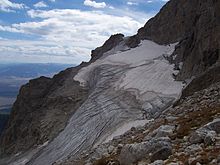Grand Teton National Park
Due to various changes in the ecosystem, some of them human-induced, efforts have been made to provide enhanced protection to some species of native fish and the increasingly threatened whitebark pine.
Grand Teton has several National Park Service–run visitor centers and privately operated concessions for motels, lodges, gas stations, and marinas.
During their return trip from the Pacific Ocean, expedition member John Colter was given an early discharge so he could join two fur trappers who were heading west in search of beaver pelts.
[25] Beginning in the 1920s, the automobile provided faster and easier access to areas of natural beauty and old military roads into Jackson Hole over Teton and Togwotee Passes were improved to accommodate the increased vehicle traffic.
[27][28] By 1907, in an effort to regulate water flow for irrigation purposes, the United States Bureau of Reclamation had constructed a log crib dam at the Snake River outlet of Jackson Lake.
[29][30] Further dam construction plans for other lakes in the Teton Range alarmed Yellowstone National Park superintendent Horace Albright, who sought to block such efforts.
[31] Jackson Hole residents were opposed to an expansion of Yellowstone, but were more in favor of the establishment of a separate national park which would include the Teton Range and six lakes at the base of the mountains.
[28] Congressional efforts to prevent the expansion of Grand Teton National Park ended up putting the Snake River Land Company's holdings in limbo.
By 1942 Rockefeller had become increasingly impatient that his purchased property might never be added to the park, and wrote to the Secretary of the Interior Harold L. Ickes that he was considering selling the land to another party.
[41] New routes on the peaks were explored as safety equipment and skills improved and eventually climbs rated at above 5.9 on the Yosemite Decimal System difficulty scale were established on Grand Teton.
[47] The park also manages 27 concession contracts that provide services such as lodging, restaurants, mountaineering guides, dude ranching, fishing and a boat shuttle on Jenny Lake.
[53][54][55] Moulton Ranch Cabins, a one-acre (0.40 ha) inholding along the historic Mormon Row was sold to the Grand Teton National Park Foundation in 2018.
[60] The National Park Service could only acquire the land at its appraised value, leaving charitable organizations to cover the higher sale price demanded by Wyoming legislators.
[77] Cascade Canyon is sandwiched between Mount Owen and Teewinot Mountain to the south and Symmetry Spire to the north and is situated immediately west of Jenny Lake.
Commencing 66 million years ago the Laramide orogeny was a period of mountain-building and erosion in western North America that created the ancestral Rocky Mountains.
[90] During the Quaternary, landslides, erosion and glacial activity deposited soils and rock debris throughout the Snake River valley of Jackson Hole and left behind terminal moraines which impound the current lakes.
In this ecotone, forested islands surrounded by sagebrush expanses provide shelter for various animal species during the day and nearby grasses for nighttime foraging.
[105] Whitebark pines generally thrive at elevations above 8,000 ft (2,400 m) and produce large seeds that are high in fat content and an important food source for various species such as the grizzly bear, red squirrel and Clark's nutcracker.
[107] Whitebark pine has generally had a lower incidence of blister rust infection throughout the Greater Yellowstone Ecosystem than in other regions such as Glacier National Park and the Cascade Range.
While general practice in national parks is to allow nature to take its course, the alarming trend of increased disease and mortality of the vital whitebark pine trees has sparked a collaborative effort amongst various government entities to intervene to protect the species.
[110] In addition to gray wolves, another 17 species of carnivorans reside within Grand Teton National Park including grizzlies and the more commonly seen American black bear.
[113] In addition to trumpeter swans, another 30 species of waterfowl have been recorded including blue-winged teal, common merganser, American wigeon and the colorful but reclusive harlequin duck which is occasionally spotted in Cascade Canyon.
[121] An estimated 10,000 insect species frequent the park; they pollinate plants, provide a food source for birds, fish, mammals, and other animals, and help in the decomposition of wood.
[123] In one example of the importance of insects to the ecosystem, swarms of Army cutworm moths die in huge numbers after mating and provide a high fat and protein diet for bears and other predators.
One study conducted 15 years before the 1988 Yellowstone National Park fires concluded that human suppression of wildfire had adversely impacted Aspen tree groves and other forest types.
[134] Grand Teton National Park is more than 100 mi (160 km) air distance from any major urban or industrial area, and localized human activities have generally had a very low environmental impact on the surrounding region.
[141] The north face route to the summit of Grand Teton is a world-renowned climb involving a dozen distinct pitches and is rated at grade 5.8 in difficulty for the 3,000-foot (910 m) vertical ascent.
Additionally, full hookups for recreational vehicles are at the concessionaire-managed 112 campsites at Colter Bay Village and another 100 at Flagg Ranch in the John D. Rockefeller Memorial Parkway.
[159] In an effort to keep the park waterways free of various invasive species such as the Zebra mussel and whirling disease, boaters are expected to abide by certain regulations including displaying a self-certification of compliance on the dashboard of any vehicle attached to an empty boat trailer.
[177] South of Jackson Lake Dam, the Signal Mountain Lodge is managed by Forever Resorts and provides cabins, a marina, a gas station and a restaurant.




















